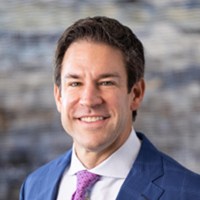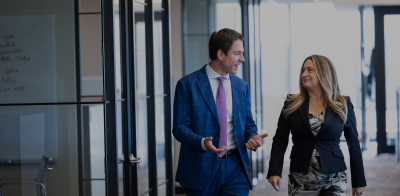Last week, FS Investments proudly served as the lead sponsor of the inaugural SCALE conference at the Bellagio in Las Vegas. SCALE’s mission is to create a global ecosystem where capital, innovation, and purpose collide. In this strategy note, I’d like to recap some of my key takeaways from the conference.
One of the key strengths of the event was the diverse nature of the content—from timely investment strategies, to the progress the industry has achieved democratizing alternatives, the outlook for the U.S. economy and markets, insights into the current political and geopolitical environment, health and wellness, artificial intelligence, impact investing for profit and not just virtue signaling, and entertainment (there is nothing wrong with having a little fun after all). The investment ideas came from a wide range of strategies in terms of risk/reward profile (where they sit on the efficient frontier1), liquidity, ease of access/level of democratization, correlation/sensitivity to equities and fixed income, etc.—from venture capital to daily liquid alts and everything in between. Real estate and corporate private credit, private equity, real estate equity, corporate and noncorporate securities, and growth lending are some examples.
Key macro takeaways
- Recession risk is by far and away as elevated as it has been in the post-pandemic environment—prepare accordingly.
- Now that the Fed, Treasury and FDIC engineered mini-banking crisis emergency measures have ended, liquidity is once again being sucked out of markets and the economy at a record pace—prepare accordingly.
- In fact, for the first time in the current bear market, we are entering a period where not only will the U.S. Treasury be pulling upwards of $1 trillion out of markets (trillion with a T) as they issue T-Bills and notes at a furious pace to replenish their checkbook, but also, the Fed is back to aggressive quantitative tightening2 while bank lending has stagnated, driven by both a risk-adverse banking system and a still massively inverted yield curve.
- Over the last 18 months, these three aforementioned factors have never overlapped.
- Clearly, this means money supply will continue to contract at close to a record pace, but perhaps a bit slower than March’s 14% annualized pace when banks were failing.
- Getting Fed Core personal consumption expenditures (PCE) and Consumer Price Index (CPI) back to 2% will take a long time and will almost certainly require a recession to get there.
- The Fed’s response to a recession will be far more “mission accomplished” than “we gotta cut rates aggressively again.” The days of quantitative easing3 are over unless there is an economic or market calamity, which fortunately no one expects.
- If you are waiting on China, Europe, Japan or Antarctica (just kidding) bailing out the global economy, you’ll be waiting a long time…demographics are destiny after all.
Key investment takeaways
- The democratization of ALTS has come a long way in a short time and the majority of alternative strategies can now be accessed through user-friendly structures that enable the average investor to access similar strategies as massive institutions, including multi-strategy hedge fund solutions. However, there will always be some strategies that cannot be democratized for the following reasons:
- Capacity constrained/extremely limited access.
- Too volatile/cyclical—the strategy has to be full cycle and timing entry and exit point cannot dominate the investment outcome.
- Too complex—if you need a PhD in Chemical Engineering to understand the strategy, good luck getting investors to embrace it.
- Private equity secondaries in regulated investment company structures are, for the first time, a democratized solution and have an advantage over early moving institutions.
- There is no J-curve where you have to wait four to five years to break even, after paying fees on committed capital (as opposed to invested capital).
- Secondary Sellers are predominantly large institutions that need to decrease their private equity exposure after gorging on private equity the past five years. Guess who could be potentially buying those secondaries at a 10% to 30% discount to net asset value (NAV)? You and/or your investors!
- Credit has become a much more attractive place to invest now that interest rates have increased and spreads have modestly widened. You might not have the same upside as equities if the Fed and economy thread multiple needles and the entire $20.6 trillion of existing market liquidity surges into AI-related investments over the next three months, and the galactic mean reversion thesis is short-circuited by another mini bubble. However, you have far less downside and can generate returns far in excess of what was available 18 months ago.
- Universally, all participants believed it is the best time to be a private lender since coming out of the global financial crisis. Commercial real estate (CRE) credit is currently more attractive than CRE equity as far as the eye can see, and newer vintage private corporate credit is enjoying the best risk/reward in years. The growth in private credit will continue to mitigate default rates as liquidity is provided to good companies at the super senior part of the capital structure (bankruptcy prevention debtor-in-possession (DIP) loans). However, a better lending environment is necessary but not sufficient to monetize the opportunity. The manager or strategy needs sufficient dry powder to make loans as wider spreads and lower LTV’s. Unfortunately, there are examples of market participants talking up the opportunity without a realistic logistical path to take advantage of it.
- Credit Securities:
- No one was brave enough to call the wides in credit spreads or the peak of defaults this cycle. However, it was consensus that the cycle would be far milder than 2000 to 2002 and the global financial crisis.
- If you can tolerate liquidity and volatility, structured credit like CLOs, RMBS, and CMBS may offer superior risk/reward relative to high yield bonds and leveraged loans.
- Expect a lot of pain in the leveraged loan market the next 12 months.
- S&P 500 equity multiples of 19.3X make absolutely no sense at all, given the economic and liquidity trajectory.
- Longer-dated Treasury yields have probably peaked, but the Fed may have one or two more hikes left in them.
- Tight real estate underwriting standards (both in housing and commercial) are one of the key reasons why the risk of a repeat of the global financial crisis is so low.
- Venture capital equity investments will be challenged for some time, but we have entered a golden age for venture/growth lending.
- The commodity complex has been starved of capital for years which means higher lows in the upcoming recession and higher highs in the next economic recovery. Copper is still the only major commodity with a clear path to a Supercycle.
- AI is real and will certainly disrupt labor markets over time, increase productivity and potentially short-circuit the current secular bull market in labor. However, markets are getting a little ahead of themselves in terms of valuations for AI-related investments.
Political/geopolitical/other takeaways
- On the domestic political and geopolitical fronts, the key phrase I took away from our many speakers was “leadership responsibility.”
- Whether discussing the debt ceiling, Russia’s unprovoked and sustained attack on Ukraine or our challenging relationship with China, it is as clear to me as it has ever been that we need elected and appointed leaders who prioritize the public and economic safety of Americans and our allies above their own personal political ambitions.
- While our speakers may have disagreed on certain policies, and some were promoting their own political ambitions or books, they all agreed the USA’s role in defending Ukraine is critical to protecting the people of Ukraine, securing other European countries and European political stability, deterring China from invading Taiwan and maintaining world order.
- Finally, our speakers, regardless of their party affiliation, expressed concern over our relationship with China and the threats Chinese aggressions pose the United States and our allies. This is an area to track, for sure, as our economics are so deeply intertwined with China, yet China still engages in open and clandestine activity that hurts the United States. Anti-China sentiment is bi-partisan and house and senate committees are heavily scrutinizing China’s drug trafficking, technology theft, military expansion and more.
- The inside perspective SCALE provided was fascinating. I enjoyed the public political discussions — Trump’s strong hold on a large minority of the Republican base and the difficulty his primary opponents will have overcoming it, Trump’s low ceiling in a general despite his high floor in the primary and concerns over Biden’s frailty — and the candid debates some of us had over dinner.
- I also appreciated the perspective of those no longer pursuing political relevance. They seemed to have a more balanced and responsible view of the issues and all expressed concern over today’s extremely combative political discourse, the unreasonable and irresponsible positions some members of Congress are taking and, of course, the elevated political violence.
- What does all that mean for the markets? It means our country still has a leading role in influencing world order and the markets, still has leaders who appreciate that awesome responsibility and still has lingering problems that challenge our ability to lead responsibly.
- I wonder who could emerge today to be the unifying and mollifying figure we need to ensure the United States continues to lead responsibly, restores its reputation globally and calms the destabilizing extremism domestically.
- Perhaps one of our SCALE participants could be that person. I know this much: all of our presenters will play a role. That’s one of the reasons why I am already looking forward to next year’s conference, which will take place amid a presidential election year. I hope you’re there to join me! In the meantime, let’s all hold our leaders to high standards and let’s emphasize the importance of “leadership responsibility.”
Investing in alternatives is different than investing in traditional investments such as stocks and bonds. Alternatives tend to be illiquid and highly specialized. In the context of alternative investments, higher returns may be accompanied by increased risk and, like any investment, the possibility of an investment loss. Investments made in alternatives may be less liquid and harder to value than investments made in large, publicly traded corporations. When building a portfolio that includes alternative investments, financial professionals and their investors should first consider an individual’s financial objectives. Investment constraints such as risk tolerance, liquidity needs and investment time horizon should be determined.
- The efficient frontier is the set of optimal portfolios that offer the highest expected return for a defined level of risk or the lowest risk for a given level of expected return. Portfolios that lie below the efficient frontier are sub-optimal because they do not provide enough return for the level of risk. Portfolios that cluster to the right of the efficient frontier are sub-optimal because they have a higher level of risk for the defined rate of return.
- Quantitative Tightening: Quantitative tightening is a contractionary monetary policy tool used by central banks to reduce the level of money supply, liquidity and general level of economic activity in an economy. The Federal Reserve is using quantitative tightening to shrink its securities portfolio by allowing the bonds it holds on its balance sheet to mature without replacing the full amount.
- Quantitative Easing: Quantitative easing is a monetary policy tool used by central banks, like the Federal Reserve, to reduce interest rates and increase money supply though purchasing securities from the open market.




